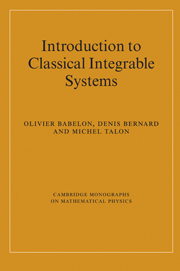Book contents
- Frontmatter
- Contents
- 1 Introduction
- 2 Integrable dynamical systems
- 3 Synopsis of integrable systems
- 4 Algebraic methods
- 5 Analytical methods
- 6 The closed Toda chain
- 7 The Calogero—Moser model
- 8 Isomonodromic deformations
- 9 Grassmannian and integrable hierarchies
- 10 The KP hierarchy
- 11 The KdV hierarchy
- 12 The Toda field theories
- 13 Classical inverse scattering method
- 14 Symplectic geometry
- 15 Riemann surfaces
- 16 Lie algebras
- Index
1 - Introduction
Published online by Cambridge University Press: 19 August 2009
- Frontmatter
- Contents
- 1 Introduction
- 2 Integrable dynamical systems
- 3 Synopsis of integrable systems
- 4 Algebraic methods
- 5 Analytical methods
- 6 The closed Toda chain
- 7 The Calogero—Moser model
- 8 Isomonodromic deformations
- 9 Grassmannian and integrable hierarchies
- 10 The KP hierarchy
- 11 The KdV hierarchy
- 12 The Toda field theories
- 13 Classical inverse scattering method
- 14 Symplectic geometry
- 15 Riemann surfaces
- 16 Lie algebras
- Index
Summary
The aim of this book is to introduce the reader to classical integrable systems. Because the subject has been developed by several schools having different perspectives, it may appear fragmented at first sight. We develop here the thesis that it has a profound unity and that the various approaches are simply changes of point of view on the same underlying reality. The more one understands each approach, the more one sees their unity. At the end one gets a very small set of interconnected methods.
This fundamental fact sets the tone of the book. We hope in this way to convey to the reader the extraordinary beauty of the structures emerging in this field, which have illuminated many other branches of theoretical physics.
The field of integrable systems is born together with Classical Mechanics, with a quest for exact solutions to Newton's equations of motion. It turned out that apart from the Kepler problem which was solved by Newton himself, after two centuries of hard investigations, only a handful of other cases were found. In the nineteenth century, Liouville finally provided a general framework characterizing the cases where the equations of motion are “solvable by quadratures”. All examples previously found indeed pertained to this setting.
Information
- Type
- Chapter
- Information
- Introduction to Classical Integrable Systems , pp. 1 - 4Publisher: Cambridge University PressPrint publication year: 2003
Accessibility standard: Unknown
Why this information is here
This section outlines the accessibility features of this content - including support for screen readers, full keyboard navigation and high-contrast display options. This may not be relevant for you.Accessibility Information
- 1
- Cited by
